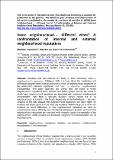Files in this item
Same neighbourhood ... different views? A confrontation of internal and external neighbourhood reputations
Item metadata
| dc.contributor.author | Permentier, Matthieu | |
| dc.contributor.author | Van Ham, Maarten | |
| dc.contributor.author | Bolt, Gideon | |
| dc.date.accessioned | 2016-01-06T16:40:02Z | |
| dc.date.available | 2016-01-06T16:40:02Z | |
| dc.date.issued | 2008-10-27 | |
| dc.identifier | 2602731 | |
| dc.identifier | 30d5731a-4dbf-48a1-8c44-46244a585d42 | |
| dc.identifier | 000260325900002 | |
| dc.identifier | 55449121443 | |
| dc.identifier.citation | Permentier , M , Van Ham , M & Bolt , G 2008 , ' Same neighbourhood ... different views? A confrontation of internal and external neighbourhood reputations ' , Housing Studies , vol. 23 , no. 6 , pp. 833-855 . https://doi.org/10.1080/02673030802416619 | en |
| dc.identifier.issn | 1466-1810 | |
| dc.identifier.other | ORCID: /0000-0002-2106-0702/work/64697523 | |
| dc.identifier.uri | https://hdl.handle.net/10023/7983 | |
| dc.description.abstract | Residents and non-residents are likely to think differently about a neighbourhood's reputation. Relatively little is known about the similarities and differences between these internal and external types of neighbourhood reputation or the relationship between reputations and 'real' or 'objective' neighbourhood characteristics. This paper addresses two points: first, the extent to which neighbourhood reputations differ between and within groups; second, the extent to which these neighbourhood reputations are associated with measured neighbourhood characteristics. Data from a specially designed survey carried out in 24 neighbourhoods in Utrecht, the fourth largest city in the Netherlands, are used. Analysis of the data showed that neighbourhood reputations are rated higher by residents and estate agents than by other city residents. Within the group of other city residents, differences were found in how neighbourhood reputations are rated by socio-economic status, ethnicity and educational background. Further, it was found that neighbourhood reputations are correlated with measured social characteristics of the neighbourhood, while physical and functional neighbourhood characteristics are of less importance. | |
| dc.format.extent | 23 | |
| dc.format.extent | 998764 | |
| dc.language.iso | eng | |
| dc.relation.ispartof | Housing Studies | en |
| dc.subject | Neighbourhood reputations | en |
| dc.subject | Residents | en |
| dc.subject | Non-residents | en |
| dc.subject | Neighbourhood characteristics | en |
| dc.subject | The Netherlands | en |
| dc.subject | Residential preferences | en |
| dc.subject | Urban neighborhoods | en |
| dc.subject | Estate regeneration | en |
| dc.subject | Scaling approach | en |
| dc.subject | Housing estates | en |
| dc.subject | Social mix | en |
| dc.subject | Segregation | en |
| dc.subject | Policy | en |
| dc.subject | Stigma | en |
| dc.subject | City | en |
| dc.subject | H Social Sciences (General) | en |
| dc.subject | SDG 11 - Sustainable Cities and Communities | en |
| dc.subject.lcc | H1 | en |
| dc.title | Same neighbourhood ... different views? A confrontation of internal and external neighbourhood reputations | en |
| dc.type | Journal article | en |
| dc.contributor.institution | University of St Andrews. Geography & Sustainable Development | en |
| dc.contributor.institution | University of St Andrews. School of Geography and Geosciences | en |
| dc.identifier.doi | 10.1080/02673030802416619 | |
| dc.description.status | Peer reviewed | en |
This item appears in the following Collection(s)
Items in the St Andrews Research Repository are protected by copyright, with all rights reserved, unless otherwise indicated.

